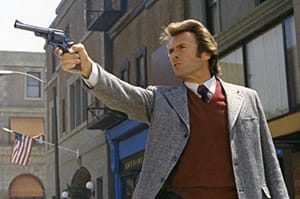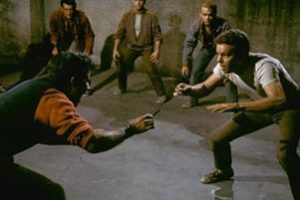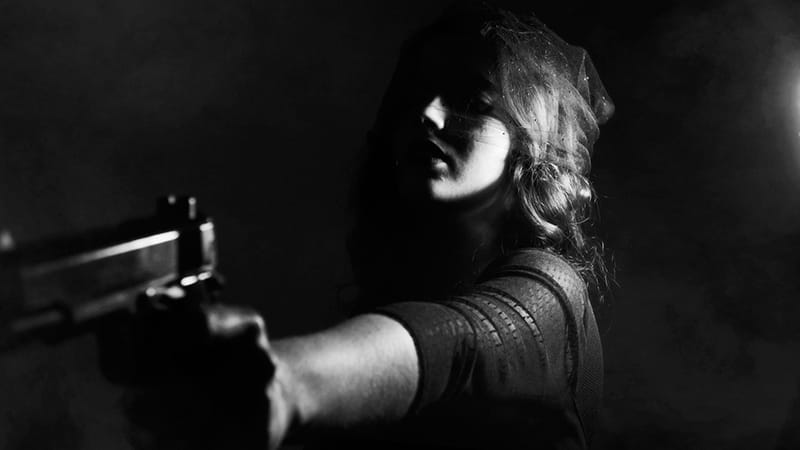Table of Contents
Today we’re going to talk about how to write a fight scene, specifically gunfight and knife-fight scenes.
Written well, fight scenes provide action; grip the reader; contribute to atmosphere and mood; and show the reader the strength and conscience of the protagonist, victim, or villain. Written poorly, they’re just as damaging to an otherwise good book as the worst-written sex scene.
As a matter of fact, any time you are tempted to say, “It’s just a story! It’s part of the action! It doesn’t have to be realistic!” don’t. As evidence, keep reading!
A Poorly Written Fight Scene is Like a Poorly Written Sex Scene
As proof, let’s explore what a badly written sex scene looks like. Don’t worry, I wrote it. There’s no nudity, because you don’t have to get that far to show the true badness of a badly written sex scene.
Why a sex scene? Because I’m guessing more of you have had sex than have shot someone.
The Botched Sex Scene
Victoria ran her hand through her own long blonde locks and pouting lips. Looking at Jacquard, Victoria’s bosoms heaved beneath her tight cotton T-shirt, and she looked down appreciatively at her own long legs. She noted with satisfaction that her spiked heels only made her legs look longer. I have to be in surgery in an hour! she thought, grateful that she wore her scrubs to the Starbucks. All I need to do is wash my hands, and I’m ready to operate. She breathed in the smell of Starbucks coffee and hoped that Jacquard would talk to her. She uncorked her latte and played seductively with the cork.
“Going my way?” he said, kneeling to talk to her and tipping his top hat. She looked into his soft brown eyes from beneath her lashes and noted the broadness of his shoulders.
He motioned to the back, and they found themselves behind the strip mall.
As soon as the door slammed behind them, he kissed her, pushing her back against the door. As she felt the cold steel of the door against her back, he kissed the back of her neck, she felt the cold of the metal door of the service entrance against her breasts. He kissed her ruby lips hungrily. He had pinned her against the wall with both hands. He stroked her face while he kept her pinned to the wall, the other hand reaching for his zipper.
Whaa?
If your fight scene is as bad as that sex scene, how many copies do you think your book will sell? We’re told that a surgeon plans to wear the clothes she wore on the street into the operating room and that she plans to wear spike heels. Jacquard is wearing a top hat. Here are wrong clothing and wrong surgical protocol. In a fight scene, your audience will notice if the combatant is wearing the wrong clothing or follows the wrong protocol.
The surroundings are wrong, and the equipment is wrong. A cork on a latte? Lattes come in a paper or plastic cup with a weird lid, and they are definitely not corked. Similarly, you might put the wrong ammunition in the firearm or have the wrong firearm issued to your relevant police department.
Your audience will similarly notice if someone tries to load a Glock with a clip or, for that matter, if your Nazi WWII villain carries a Glock at all.
There are anatomical problems. She looks at him from beneath her lashes, but she has to look down to see him. Victoria is facing the wrong direction for the things he’s doing to her and Jacquard apparently has four arms. Similarly, if your protagonist kicks the bad guy in the nuts while at the same time holding him in a rear naked (carotid) choke, your reader is not going to react well. Bonus, is Jacquard’s top hat an affectation? Because people don’t wear those in the 2020s. Similarly, if your police officer is wearing the wrong uniform for the year, your readers will notice.
It doesn’t matter if the sex scene gets steamy later or isn’t dreadful on the next page. Jacquard sounds like he belongs in Men in Black. Victoria is going to bring alley germs and pointy heels into an operating room.
You might try to count on your readers’ ignorance, but do you really have that little respect for them? They’ll notice, and they will return that lack of respect in kind.
What Your Reviewers Will Say
At the end of Chapter Five, Hood tells us that Kane carries a “Zig nine-one-one backup pistol.” There is no such thing. Zig, a Turkish firearms manufacturer, makes a semi-automatic pistol called the “Zig 1911 Pistol,” but it appears to be more suitable for use as a primary weapon, rather than a backup, because it has a five inch barrel and comes chambered in .45 ACP caliber ammunition. We have been told that Kane’s primary weapon is a Glock 22, which is a .40 caliber weapon with a 4½ inch barrel, so why would the backup weapon be even bigger, and more powerful, than the primary weapon?
It makes no sense.
***
Another gun inconsistency in the book is the assertion that Deputy Kane is creeping through the snow “straining to listen for another gunshot. He would have a millisecond to react . . .” Umm . . . Nope! Rifle bullets travel faster than the speed of sound. If he was shot, he would never hear the gunshot before the bullet struck him.
***
Another gun inconsistency is that Kane “slid a bullet into the chamber” of his Glock before putting it back into his holster. Why wouldn’t there already have been a cartridge in the chamber? If not, why carry a Glock? Cops have to rack the slides of their handguns before using them only in poorly made TV shows and movies, and in poorly managed law enforcement agencies.
That reviewer isn’t even the most negative for that book. In fact, a romp through Amazon’s one-star reviews will be quite the education in what readers notice and what they hate. I hope you understand, then, that if you want to take liberties with facts, it won’t be pretty.
4 Elements of a Fight Scene You Must Get Right
- The fight
- The injuries sustained in the fight
- The physical capacities of the characters injured in the fight
- The behavior of the characters in the aftermath
I’m going to address gunfights and stabbings today and fistfights on another day.
How to Write a Fight Scene with Guns

Let’s get one thing out of the way before we go any further. People don’t fly backward when you shoot them. If they fall, they drop like a sack of groceries.
On the other hand, shooting them might not stop them at all. People can take a lot of bullets and still do a lot of damage to their opponent. So if your protagonist is about to get into the driver’s seat, and a knifer is running at him from the trunk, every law enforcement officer knows that the protagonist can’t pull his holstered Glock 19 out and get three rounds center of mass before they’re slashed to ribbons.
I practice alongside trained law enforcement officials, and I know that’s true. So your grizzled detective who wants to catch the serial killer is going to have to use empty-hand tactics at that range.
The Twenty-One-Foot Rule
I’m going to digress for a moment, because it’s pivotal to the average gun scene. The below video speaks of the twenty-one-foot rule. That rule says that in order to defend yourself using a firearm, your attacker has to be at least twenty-one feet away from you for you to have time to draw your holstered sidearm and hit them with two rounds center of mass.
This is fiction.
Why?
Look at this thing.
What’s wrong with it?
Did you notice what the knifer helpfully did? He dropped dead. Wasn’t that nice of him? And the shooter didn’t miss. Studies show that officers miss about 50 percent of the time. Some studies show that their aim is worse than that. And police officers are trained. If your character isn’t trained, their aim won’t be as good, especially since when your bloodstream is full of adrenaline, you do everything less well.
At my fight school, we learned that at twenty-one feet, your attacker has plenty of time to stab you, bash you in the head, or otherwise maul you, even if what they do next is drop dead. What’s safest for a defender is thirty feet. Our training center has invited journalists to see this for themselves, but they won’t go.
So if your character is shooting at a villain who is armed with a baseball bat, and your character is closer than about thirty feet, your character could still get their head bashed in.
What I’ve just said about accuracy is germane to what body part your character is going to be able to hit when they shoot at the bad guy. Do not by all that’s holy have your protagonist shoot the gun out of anyone’s hand. It’s just about impossible. Now don’t write me and insist that someone has done it. I’m sure that someone somewhere has done it—just like a couple of people have been sucked out of airplanes miles in the air and lived. That doesn’t mean you should go skydiving with no parachute.
I’m saying that it’s luck, and your buddy better be standing stock still, calmly waiting to permanently lose his ability to type obscenities on social media—because he won’t have a head. At best. Because even with a cooperative Darwin Award–winner, what’s most likely to happen is that you miss the poor dear completely.
There was a time when your readers might not have known any of this. Sadly, mass shootings happen every day now, and the prevalence of surveillance cameras means that you can watch videos of people getting shot. Lots of people have shot other people and YouTube is a wondrous place. There are news accounts; there are eyewitness accounts.
You just can’t fake it anymore.
On the other hand, even though you might be really depressed that your shooting victims don’t get to fly backward, and your protagonist doesn’t get to shoot the gun out of the bad guy’s hands, your bad guy can look really terrifying when he’s shot ten times and still manages to throttle the victim before he drops dead.
Where Does it Hurt?
Take into account that gunfire is loud. Your protagonist will have ringing in the ears. A police officer in a murder case I prosecuted testified about a shotgun going off near him. He was beside the front door of a house when the defendant shot his mother from that front door. It made the officer temporarily deaf.
Also understand that not all guns and bullets make the same kinds of holes. Make sure that the gun your character is using can inflict the injuries that you describe. Don’t take that for granted. Make sure that at the end of the fight, when the living look at the dead, the bullet holes look like they should based on caliber, proximity, angle, and whether there’s an exit wound. Furthermore, understand that if you want the character to live, you’re going to have to make sure that a gunshot in the relevant body part using the relevant gun with the relevant bullets can inflict the injuries you want. There are plenty of sources online for this kind of information, and you’d be surprised at the number of ways that it’s possible to get it wrong. Don’t underestimate the shock value in some cases of the relatively small entrance wound and the gaping exit wound.
One weird thing is that bullets in don’t necessarily go through and through. In fact, .22 caliber bullets can bounce around in the body and exit at some weird, unexpected angle. They can ricochet everywhere in the skull like a rogue blender blade and then pop out.
Probably don’t research this stuff on your work computer, and, also, have a strong stomach.
In related, people really do pass out watching autopsies. (I don’t.)
Adrenaline and Gunfights
In any fight, adrenaline is going to make you act and think differently. Your movements shorten up, and your aim gets worse. Your fine motor coordination drops off.
After the fact, it will be harder for you to take in even simple information for a few hours. If your protagonist can get into a bloody gunfight, look around at the carnage, and report to their pub trivia game in an hour, make sure everyone notes that they’re a superhero.
This means that the protagonist really might not notice another bad guy coming at them from behind or standing in the shadows, unless they’re trained enough to expect it. And maybe not even then. You might have read about this as tunnel vision.
The other thing that happens when you’re adrenalized is that you don’t feel pain the same way. Further, you’re less likely to remember trivial things. For instance, what color shoes was the killer wearing?
Writing a Mass Shooting
If your protagonist is caught in a mass shooting, several things will be true.
First, it’s not likely that she will be able to shoot the bad guy from across the room without hitting someone else for the same reason you can’t shoot the gun out of someone’s hand. And under stress, the protagonist’s aim is going to get worse, not better. There’s a reason that SWAT snipers wait and wait and wait before shooting, and they have a spotter next to them. In a mass shooting, the shooter’s a moving target, there are people running everywhere, and things are happening very fast.
In fact, the most worrisome scenario is when there are two shooters—one of whom is the monster and the other is a good guy with a gun. How does anyone know which one is which?
Are there situations where a character could stop a shooter (or a knifer) by means of a firearm? Sure. As long there’s no one else in the line of fire, and the good guy is trained. In contrast, if your character tries that in the middle of a crowded middle school hallway or a dark movie theater, they will almost certainly kill a bystander.
Best to have your protagonist take the gun away using Krav Maga techniques.
When I began training in Krav Maga, and my instructors showed us how to take guns away from bad guys, I was initially skeptical. But the techniques do work to increase your chances of survival. If a character is in the line of fire as soon as the shooter walks in or is otherwise in the wrong place, it can be a bad day. Otherwise, if you want your character to disarm the shooter, it can be done. They will need to redirect the weapon, control it, attack the shooter, and take the weapon.
In that case, have the character train regularly at a Krav Maga fight school.
The Character Who’s Been Shot
No, a gunshot to the shoulder is not innocuous. There’s a lot of real estate in there, including some major arteries and a lung. Your protagonist is not going to be using that shoulder—maybe not ever again. Can he luck out? Sure.
Can someone be shot in the head and still talk on the way to the hospital? Sure they can. Can someone be shot in the head and live? All the time. Does the doctor have to remove the bullet? Not without more. If you want your character to be shot and live, just have them be shot and live.
Can they wrap themselves up and then get in a car and go after the bad guys? Not likely. In fact, if the protagonist is shot with an AR-15, there might not be much left of him at all.
Fighting over the Gun
On screen, it can look dramatic, I guess. The camera films the action at the level of the gun—doesn’t it always?—and both the bad guy and the protagonist wrestle, pummel each other, and each try to drag themselves toward the gun.
It’s really stupid.
Lying there on the floor, the gun isn’t hurting anyone. If the good guy is in mount position (on top of their opponent), the good guy should beat the shit out of them. A skilled fighter should not waste time and energy diving for the gun. If the opponent is unconscious, then the gun is a paperweight. Your characters should know better.
Writing Fight Scenes with Knives

If you are imagining two seasoned fighters going at each other with a knife, Gamesters of Triskelion–style, Kirk music blaring, don’t.
A knife attack looks like a sewing machine. The attacker pins the victim against the wall and stabs repeatedly, and the untrained victim tries to catch the butterfly, the hand with the knife, and stop it. The victim can be stabbed dozens of times in a minute or so. It’s usually not survivable.
The other kind of attack is where a pedestrian is walking down the street and is stabbed by a terrorist. These attacks are on YouTube, if you care to find them. They happen very fast. The victim might just feel like they’ve been punched. There is also a YouTube video out there where two men are squaring off on the street. One of them walks over, gives the other one overhead stab, and takes a few steps backward. The victim takes a few steps away and collapses, dead. I had to rewind several times to catch (1) that the victim was stabbed and (2) the moment of the stabbing.
Can the knifer just slash wildly? Yes. But that’s happening very fast.
Your martial artist protagonist fighting off a knifer is almost certainly still going to be stabbed or slashed. They just might get cut fewer times than an untrained person would, and they are more likely to avoid getting stabbed or slashed in vital areas. As it is said in my fight school, “It’s better to be stabbed once than twice, twice than three times, and so on and so on…”
Your protagonist is going to live longer because they’re not going to try to grab the knife, they’re going to punch the knifer in the face. Repeatedly.
There are Krav Maga techniques that will help, but basically the character will be trying to destroy the operator. The character will not try to grab the knife hand and will not be able to find just that very pressure point on the hand. Because yeah, I’ve practiced hapkido too, and we’ve already discussed that fine motor coordination evaporates under stress. The character will try to protect vital organs and vulnerable areas and beat the daylights out of the knifer. In related, look up all the places where arteries are close to the surface.
If someone does approach a character with the knife over their head like the Black Knight’s first opponent in Monty Python and the Holy Grail, or—even more manageably—puts the knife against a character’s throat, there is less risk, but your protagonist might still be cut. There are techniques to respond to this kind of attack as well.
The object after a knife attack is to stop that bleeding—speaking of which, it’s not uncommon for the knife hand of the stabber to slip down the grip and onto the blade and so your knifer might have injuries to the hands.
If the victim has the knife in them, don’t have the protagonist pull out the knife. Leave it there and let the ER trauma surgeon deal with it. That’s the right way to handle it, since pulling a knife out of the body reinjures the victim on the way out, and the knife may be blocking some blood vessels and reducing at least some of the bleeding. Plus, it looks heroic when the protagonist says to horrified onlookers, “Don’t touch the knife!”
In Conclusion
I have given you some fundamentals. You will need to look some of these things up, but now you know where to start in order to write a credible fight scene with characters armed with guns or knives.
Summing Up
- Don’t try to hoodwink your readers. They’ll despise you for it.
- Do research your weapons to make sure that they exist and that putting them in the hands of your characters does not create an anachronism.
- Make sure that the injuries are consistent with the weapon.
- Make your adrenalized characters act appropriately.
- Don’t use your work computer.






0 Comments